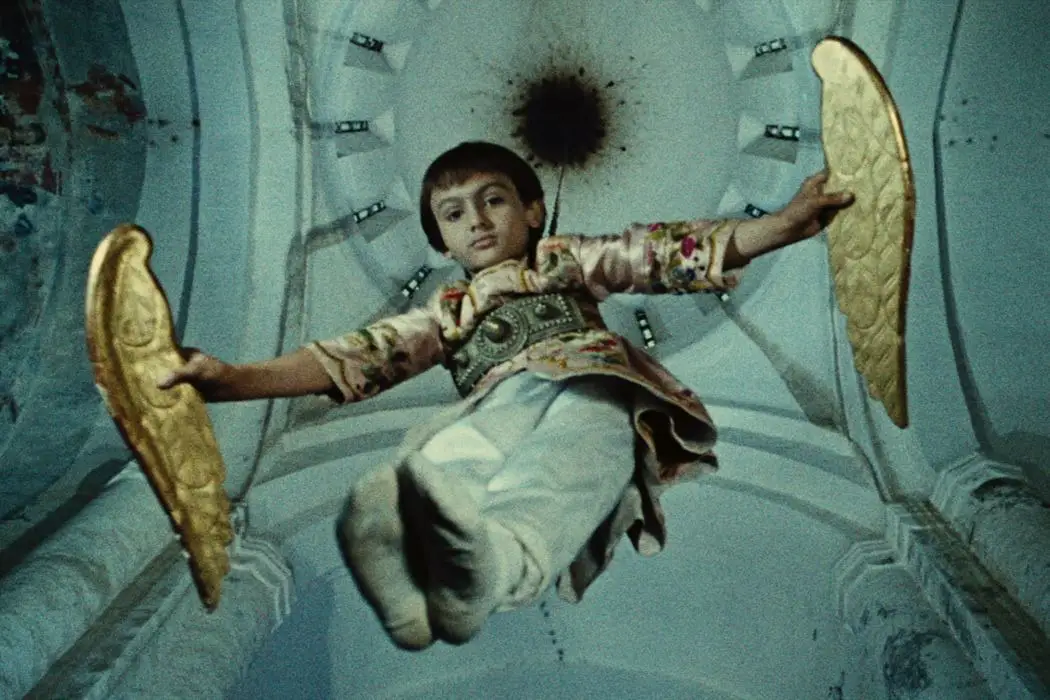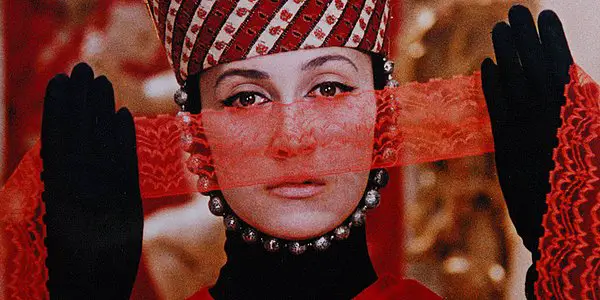The World Is A Window In THE COLOUR OF POMEGRANATES

Jack is a recent MA Graduate from the film department…
It is always a credit to the biographical film if they manage to capture a style or an emotion of the person whose life they are attempting to portray. Hayao Miyazaki’s The Wind Rises is a great example; it attempts to tell the story of the Japanese aircraft designer Jiro Horikoshi, who created machines of death but could not help from viewing them as beautiful creations.
The film is often about this personal struggle, portrayed through dream images of Jiro walking on the wings of a plane, the charred flames of ruined aircraft juxtaposed with a paper aeroplane gliding through the air. The person – the subject in question – can be captured simply, showing their art, playing their music, showing them in action, and, in a way, that is exactly what The Colour of Pomegranates tries to do.
Having Patience with Visual Poetry
The Colour of Pomegranates is a film that shows a poet in action, in flowing colour and in visual rhyme. Sergei Parajanov, a Russian filmmaker, made The Colour of Pomegranates in 1969 to tell the life-story of Sayet-Nova, a famous Armenian poet and songwriter, through a visual language and style that has been discerned and interpreted from the art of the poet.
It is a film that begins with a warning that “The filmmaker has tried to reflect the poet through the trepidations of his soul, his passion and torments” and continues with colourful, strikingly focused images that occasionally can be seen telling the story of a young boy growing up. It is visual poetry in the purest sense, poetry that, unlike the written word, does not wait for its audience to catch up, to understand – The Colour of Pomegranates flows forward like a river and is seemingly unperturbed as to whether the viewer gets swept along with it.
This is a film that has absolutely no patience to adhere to those of the audience with no imagination or willingness to accept its vision. It is art that paradoxically means both exactly what the audience makes of it, while also telling a very specific, very real story. There are images throughout that are perplexing and totally bizarre, and any kind of viewer who is not aware of the context of the film and is not already familiar with the work of Sayet-Nova, will have no choice but to divulge their own interpretations.

Near the beginning of the film was some imagery involving a shell covering a part of a naked body almost suggesting to me some kind of dive into imagery inspired by the transgender – this is an interpretation I have gathered thanks to the surrealistic, confidently vague images that the film placed before me, but that is simultaneously almost certainly untrue in its hypothesis.
Making Meaning of The Colour of Pomegranates
This is an aspect of cinema that has always fascinated me personally – the desire or need for an individual audience member to interpret what is in front of them, to make sense of images they are placed in front of. It doesn’t matter if an individual is at a colossal disadvantage when faced with surrealistic images, the person interfacing with these colours and sounds and contexts will take the soul and matter of the image and run with it, creating a new meaning that did not exist before.
This is touched upon quite heavily (and quite critically) by Susan Sontag in her work Against Interpretation, where she argues vehemently it is not the role of the audience to derive meaning from what they see and hear; and to do so is a waste of time and effort. While I have taken a long-standing disagreement against her conclusion, it is difficult to argue with. After all, my efforts to discern meaning from The Colour of Pomegranates were pointless, and, unfortunately, did not give the text any more value to me personally.

If we simply take the base images of The Colour of Pomegranates, however, they are beautiful without the need to know specifically what is happening. An early image of the poet as a young boy, lying on a rooftop while hundreds of pages from books flutter all around him, is quite wonderful in its intricacies. This kind of wonder is matched later as Sayet-Nova is portrayed as an almost Jesus-like figure, with workers throwing hay up into the air to rain down upon him below, as he takes a quasi-cross position.
These are images that are marvels of cinematic language and of poetry, taking the works of this great poet and attempting to translate them into the language of film. Whether or not me, the audience member, understand these images fully (and believe me, I didn’t) is unarguably beside the point – what is more important is these images mean something to the director, and mean something to the exact audience he is striving to connect with.
Peering Into a Silent Way of Seeing
Late on in the film, the phrase “The World is a Window” is expressed through a title-card. The curious phrase seems to be a specific commentary on the way that Sayet-Nova viewed the world, and how this film now helps us view him. We are looking into his world through the window of the screen, peering into his life, his images, as he flows from childhood to teenage to Monk, and then back again.
So often in The Colour of Pomegranates the characters and figures are looking towards the audience, with silent glares and wordless whispers – are they viewing straight through the window and back onto us, seeing through the looking glass? It heightens the sense of performance engulfing the film, the sense that the audience is watching a knowing recreation, a fabrication, rather than something that believes itself to be reality.
Yet the film itself is a window into another way of seeing, another way of making films that was, quite surprisingly, still expressing itself in 1969, when this film was released. Other films released around this time were Western hits such as Midnight Cowboy, Butch Cassidy and the Sundance Kid and even the latest James Bond movie, On Her Majesty’s Secret Service.
This film is a world away, a universe away, from the cinematic language that was dominating western cinemas at this point in time, and its aspirations belong to an earlier period, a period where stories were told through images and not through words. Title-cards are scattered throughout the film and almost entirely negate the need for the voice-over, which seems included just to keep a voice present throughout the film, rather than being a totally wordless venture.
Yet that is exactly what the film could be, it could easily become a wordless project, one structured around brief title cards and dominated by excessive, intricate images, that ask the audience how just as much as why. It is not just that the film is part of a different culture and language to the other main cinematic efforts of that particular year but it applies a different way of thinking about cinema as a basic concept.

Studying silent film is a strange experience to a beginner because it seems so at odds with the cinema of today – without words, cinema had to tell its audience what was happening through the movements of the characters, the implications that a scene change had, and the way an edit told a story. The image had power in a way that is often lost in modern cinema.
The Colour of Pomegranates is in some ways similar to this initial approach to cinema and yet, as already discussed, it is not at all interested in those of its audience who cannot hope to comprehend it. While early cinema did everything in its skillset to make the audience understand what was happening, to tell a story that begins and finishes with a straight line of narrative, it is often hard to tell where the story of The Colour of Pomegranates closes and where it awakens. It is silent cinema without the need to be understood.
Conclusion: A Window of Old and New Possibilities
The Colour of Pomegranates is a window into another world. Not just a world of a different culture or a world of poetic imagery, but a world of different cinematic values entirely. This was 1969, where cinematic language was modernised, script-writing was power, and many filmmakers were not learning the lessons of the silent classics that preceded them.
It is not even clear if Parajanov intended this project to be something resembling silent cinema, or if this is a rejection of that too – undoubtedly. However, it is a film out of time and place, a film that sprung up as an oddity, a poetic marvel in the collective cinematic consciousness that blows away the cobwebs of the medium, even when viewed today.
It is a window not only into the age of silent cinema, transplanted to 1969 but a window into an entirely new way of thinking. It is moulded and shaped by the images it presents, it rattles around restlessly in any viewer who sees it; it may not even be good in the traditional sense.
Perhaps it rejects judgement, especially from those who still do not quite understand its visions. Instead, it simply is, it exists, and that seems to be all that matters. The Colour of Pomegranates is not like looking through a window. It is like viewing cinema through new eyes.
Do you agree with Sontag that it is not up to the audience to derive meaning from what they see and hear? Also, do you think the film image has lost primacy in recent decades? Let us know what you think in the comments below!
Does content like this matter to you?
Become a Member and support film journalism. Unlock access to all of Film Inquiry`s great articles. Join a community of like-minded readers who are passionate about cinema - get access to our private members Network, give back to independent filmmakers, and more.
Jack is a recent MA Graduate from the film department at the University of Southampton. He has been writing about film and football casually since 2013, considering himself as an expert on the works of Akira Kurosawa, Park Chan-wook and Steve McQueen ; less of an expert on every other important director.












